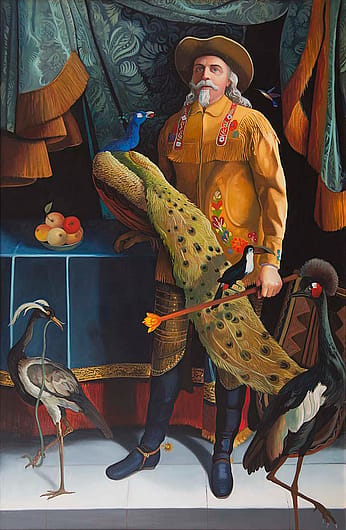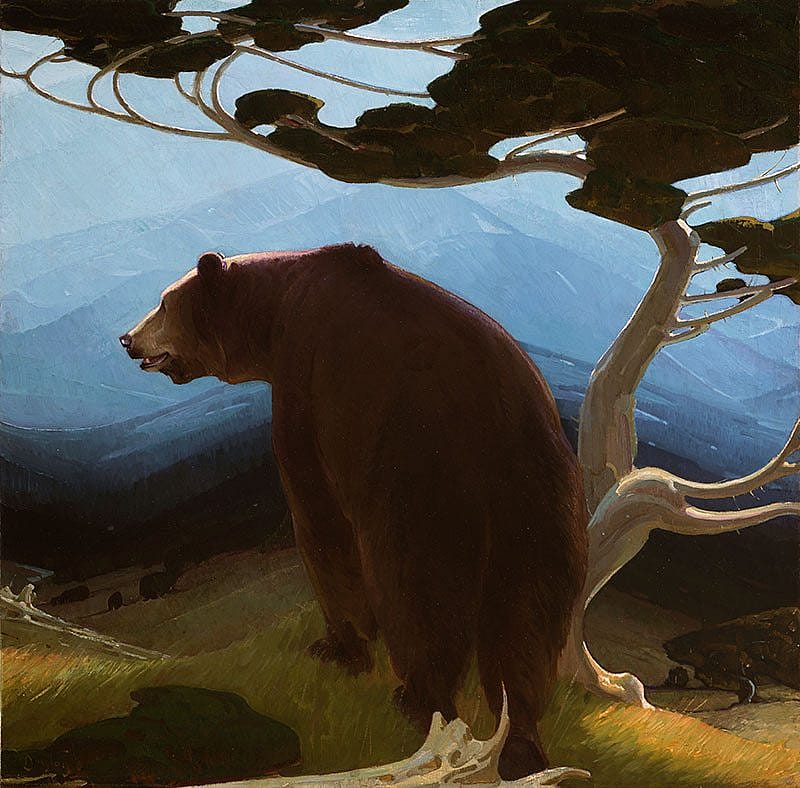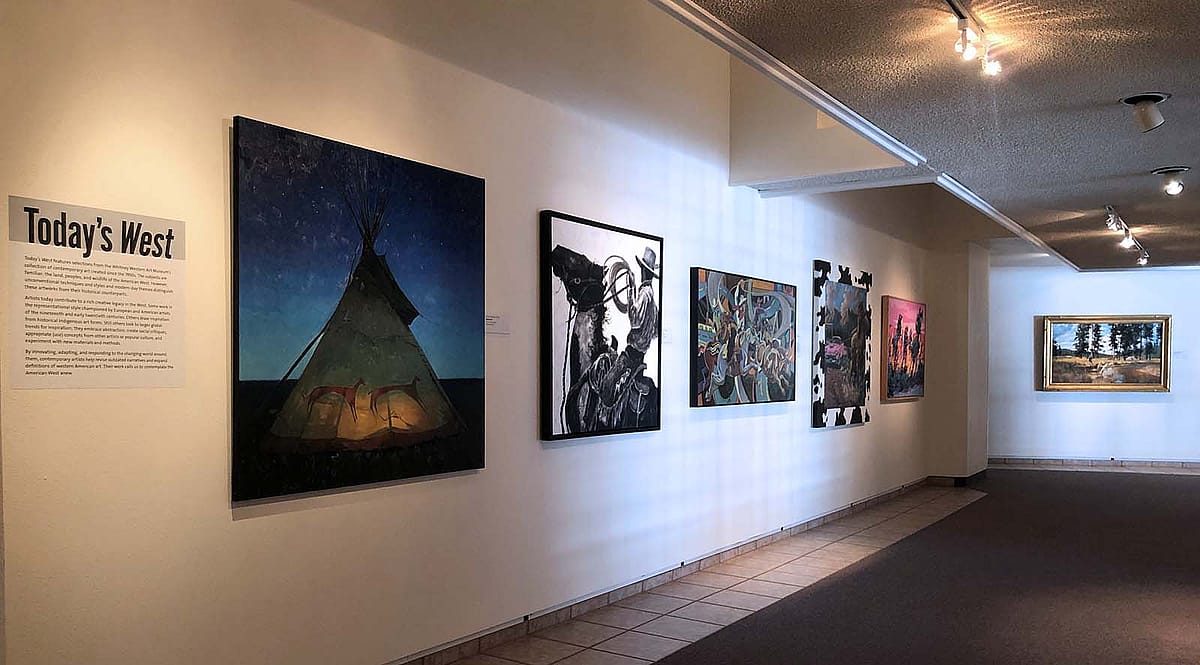Exhibits

Themes in the Whitney Western Art Museum
Where is the West (in the Whitney)?
The American West can be considered in geographical terms, though any border you draw around it might be challenged by someone else.
Artists played a major role defining the West’s location and environment through landscape paintings. Beginning in the nineteenth century, many depicted the West as untouched and fertile – awaiting settlement. However, in many cases the land was dry and difficult, or already inhabited. But whether real or imagined, for viewers, art offered inspiring glimpses of western lands.
The museum staff honors the diversity of possible place-based definitions of “the West,” but primarily exhibits artwork inspired by the Northern Plains and Rocky Mountains. The collection was founded around artwork of this region, and we continue to build this strength through acquisition.
Native Identity and Representation
How might an artist’s cultural perspective, moment in history, and personal inclinations affect their depictions of themselves or others?
Much of the artwork in the Whitney offers perspectives into American Indian life. There are Native and Non-native depictions of Indigenous peoples and events.
Non-native artists have been fascinated with American Indians for nearly two hundred years. Historically, these artists represented American Indians with little variation and drew upon western European models for their inspiration. They chose eye-catching aspects of Native dress, such as feather bonnets and beaded moccasins, to generalize Native identity in their art. Though some artists depicted Native peoples as dynamic and diverse, most helped create and reinforce stereotypes.
Yellowstone through Artists’ Eyes
Dense forests and crystal-clear lakes, abundant wildlife, candy-colored canyons and gushing geysers… these are just some of Yellowstone’s intriguing features which have fascinated artists for generations.
In the late 1860s and early 1870s, scientists and military men began investigating the Yellowstone region. They returned with stories of exotic plants and animals and otherworldly geology, confirming the earlier tales from fur trappers. Enthralled by these reports, artists from America’s East Coast and beyond sensed a unique opportunity to depict and share Yellowstone’s inspiring sights.
The allure of Yellowstone endures today. Artists continue to congregate in this impressive natural studio. From historical to contemporary, the Whitney Western Art Museum’s collection of Yellowstone art celebrates the park’s wild beauty.
Charles M. Russell (1864 – 1926)
At age 16, Charlie Russell left Missouri to seek adventure in Montana Territory. He worked as a ranch hand, and in his free time sketched and sculpted western scenes from life and his imagination. Russell was self-taught but dedicated, and soon became known as one of the foremost artists of the region.

He was and still is admired for depicting the American West during a period of great change and for portraying earlier chapters of western history. Through his drawings, paintings, and sculptures, Russell told stories of western peoples, landscapes, and wildlife. Sometimes his art was based on his own experiences and sometimes it was inspired by a nostalgic yearning for the past. Often, his art combined myth and reality.
The Whitney Western Art Museum is home to a treasure trove of art by Russell: 50 paintings, 12 illustrated letters, 97 drawings, and 194 sculptures. The museum staff exhibits the Russell collection as time, space, and the safety of the objects permits.
Contemporary West
The Whitney Western Art Museum’s collection includes contemporary art created since the 1950s. The subjects are familiar: the land, peoples, and wildlife of the American West. However, unconventional techniques and styles as well as modern-day themes distinguish these artworks from their historical counterparts.
Artists today contribute to a rich creative legacy in the West. Some work in the representational style championed by European and American artists of the nineteenth and early twentieth centuries. Others draw inspiration from historical Indigenous art forms. Still others look to larger global trends for inspiration; they embrace abstraction, create social critiques, appropriate (borrow) concepts from other artists or popular culture, and experiment with new materials and methods. By innovating, adapting, and responding to the changing world around them, contemporary artists help revise outdated narratives and expand definitions of western American art. Their work calls us to contemplate the American West anew.
Frederic Remington’s Landscape Studies

Frederic Remington is best known for his depictions of the “Old West” and military subjects. But, late in life, he turned to landscapes rather than cowboys and cavalry for his art. He created fresh works that emphasized the unique light and atmospheric conditions of the American West.
The small, impressionistic oil paintings on view are a sample of Remington’s landscape studies made in the early 1900s. A few are finished and signed. Most are quick sketches. Remington started and sometimes finished these paintings outdoors, on trips to western locations like Wyoming, or closer to his home in upstate New York. He worked swiftly to capture changing colors affected by the sun’s angle and the weather.
Consider the many hues Remington uses to recreate impressions of light:
- Lavender purple streaks for shadows on a sandy riverbank.
- Dots of orange, gold, green, and blue for a sun-dappled forest floor.
For Remington, these paintings were all about evocative use of color.
Buffalo Bill in Art

Over the years, artists have depicted William F. “Buffalo Bill” Cody in a wide variety of materials and styles.
Buffalo Bill encouraged artists to create paintings and sculptures of himself and helped shape his own legacy by commissioning celebratory artwork. He cleverly recognized the promotional value of sharing his story through words and images.
In large part because of the wide circulation of Buffalo Bill imagery, he became easily recognizable during his lifetime, and still is today. Each portrait of Buffalo Bill is unique, but artists have usually portrayed him with long hair and a goatee, wearing a cowboy hat.
When drawing, painting, or sculpting people, artists make choices that can influence our views of their subjects. Depending on the perspective of the artist (and their patron), looking at a picture of Buffalo Bill, viewers may see an energetic army scout, a lethal hunter, a swaggering showman, or another persona.
Wonders of Wildlife
Wildlife and nature have long fascinated artists working in the West, and animals are often central to depictions of the region by Native and non-Native artists.

Some of America’s most iconic species, including the American bison and the bald eagle, are endemic to the West, and countless other wild animals can be found here. Livestock, like horses and cattle – central to the West’s cowboy and ranching heritage – are abundant. With such rich biodiversity, it’s not surprising that western artists past and present choose animals as their subjects.
Visual images of animals can influence our views of wildlife and nature. Artists can choose to emphasize animals’ physical qualities and their symbolic associations. They can depict animals as spiritual beings, companions, hunting trophies, subjects of scientific study, and resources for human survival.

